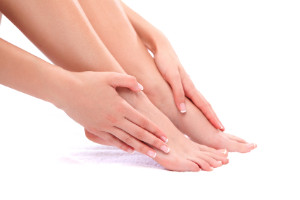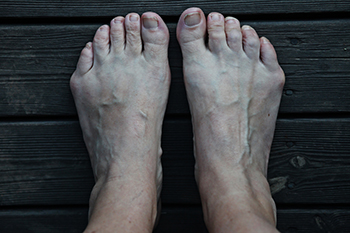Connect With Us
Blog
Items filtered by date: October 2022
Lotion Before Bed

Sometimes, an individual’s feet may become itchy during the middle of the night. This may be caused by a case of dry skin or some other medical condition. Since itching sensations during bedtime can be particularly troublesome and disruptive to sleep, there are certain things you might consider doing to prevent this from happening. Most importantly, an individual might consider applying an everyday foot moisturizer to the feet before bed at night. Lotions that contain menthol might be particularly helpful because of the cooling sensation that it produces. If the skin on the feet feels especially dry, an individual might even opt for a more significant, heavy-duty cream for the feet. If you feel itchy at night, contact a podiatrist today for more tips about foot lotion.
Everyday foot care is very important to prevent infection and other foot ailments. If you need your feet checked, contact one of our podiatrists from Omega Podiatry. Our doctors can provide the care you need to keep you pain-free and on your feet.
Everyday Foot Care
Often, people take care of their bodies, face and hair more so than they do for their feet. But the feet are a very important aspect of our bodies, and one that we should pay more attention to. Without our feet, we would not be able to perform most daily tasks.
It is best to check your feet regularly to make sure there are no new bruises or cuts that you may not have noticed before. For dry feet, moisturizer can easily be a remedy and can be applied as often as necessary to the affected areas. Wearing shoes that fit well can also help you maintain good foot health, as well as making it easier to walk and do daily activities without the stress or pain of ill-fitting shoes, high heels, or even flip flops. Wearing clean socks with closed shoes is important to ensure that sweat and bacteria do not accumulate within the shoe. Clean socks help to prevent Athlete’s foot, fungi problems, bad odors, and can absorb sweat.
If you have any questions please feel free to contact our offices located in Los Angeles, Huntington Park, and Reseda, CA . We offer the newest diagnostic and treatment technologies for all your foot and ankle needs.
It's Time for Beautiful Feet
Why Does My Foot Hurt?

A common cause of foot pain can come from wearing shoes that do not fit correctly. The shoes may be too tight, or they may be large in width and length. When shoes don’t fit properly, they can be uncomfortable and cause various foot conditions to arise. Bunions can easily develop from wearing shoes that do not have enough room for the toes to move freely in, and larger shoes may have to be purchased to accommodate the bunion. Hammertoe is a deformity, and the muscle imbalance in the toes may cause them to shift toward each other. A corn can cause debilitating foot pain when it develops on the side of the pinky toe. An ingrown toenail can develop when the toe constantly rubs against the top of the shoe and can become infected if not promptly treated. Many people develop gout which is a form of arthritis, and this can happen from eating foods that have high amounts of purines. This can contribute to having excess uric acid levels and may cause crystals to form in the joints of the big toe. If you are suffering from foot pain for any reason, please consult a podiatrist who can help you determine what the cause is and treat it appropriately.
Foot Pain
Foot pain can be extremely painful and debilitating. If you have a foot pain, consult with one of our podiatrists from Omega Podiatry. Our doctors will assess your condition and provide you with quality foot and ankle treatment.
Causes
Foot pain is a very broad condition that could be caused by one or more ailments. The most common include:
- Bunions
- Hammertoes
- Plantar Fasciitis
- Bone Spurs
- Corns
- Tarsal Tunnel Syndrome
- Ingrown Toenails
- Arthritis (such as Gout, Rheumatoid, and Osteoarthritis)
- Flat Feet
- Injury (from stress fractures, broken toe, foot, ankle, Achilles tendon ruptures, and sprains)
- And more
Diagnosis
To figure out the cause of foot pain, podiatrists utilize several different methods. This can range from simple visual inspections and sensation tests to X-rays and MRI scans. Prior medical history, family medical history, and any recent physical traumatic events will all be taken into consideration for a proper diagnosis.
Treatment
Treatment depends upon the cause of the foot pain. Whether it is resting, staying off the foot, or having surgery; podiatrists have a number of treatment options available for foot pain.
If you have any questions, please feel free to contact our offices located in Los Angeles, Huntington Park, and Reseda, CA . We offer the newest diagnostic and treatment technologies for all your foot care needs.
Several Reasons Why Stress Fractures Can Occur

Many people who develop stress fractures often continue to run through the pain that this foot condition can cause. It is a hairline fracture and may be more prevalent among people who have osteoporosis. The foot bones absorb the stress of the body, and this can easily occur if proper warmups and cool-downs are not performed. Symptoms that are generally associated with stress fractures include bruising, swelling, and tenderness in addition to difficulty in completing daily activities. Some factors can contribute to incurring a stress fracture. These can consist of having previous fractures, a lack of vitamin D, or running and jumping on uneven surfaces. An MRI is often needed to properly diagnose a stress fracture and an X-ray may follow. If you feel that you have developed this type of fracture, please consult with a podiatrist who can guide you toward the correct treatment techniques, which often begin with resting and elevating the affected foot.
Stress fractures occur when there is a tiny crack within a bone. To learn more, contact one of our podiatrists from Omega Podiatry. Our doctors can provide the care you need to keep you pain free and on your feet.
How Are They Caused?
Stress fractures are the result of repetitive force being placed on the bone. Since the lower leg and feet often carry most of the body’s weight, stress fractures are likely to occur in these areas. If you rush into a new exercise, you are more likely to develop a stress fracture since you are starting too much, too soon. Pain resulting from stress fractures may go unnoticed at first, however it may start to worsen over time.
Risk Factors
- Gender – They are more commonly found in women compared to men.
- Foot Problems – People with unusual arches in their feet are more likely to develop stress fractures.
- Certain Sports – Dancers, gymnasts, tennis players, runners, and basketball players are more likely to develop stress fractures.
- Lack of Nutrients – A lack of vitamin D and calcium may weaken the bones and make you more prone to stress fractures
- Weak Bones – Osteoporosis can weaken the bones therefore resulting in stress fractures
Stress fractures do not always heal properly, so it is important that you seek help from a podiatrist if you suspect you may have one. Ignoring your stress fracture may cause it to worsen, and you may develop chronic pain as well as additional fractures.
If you have any questions, please feel free to contact our offices located in Los Angeles, Huntington Park, and Reseda, CA . We offer the newest diagnostic and treatment technologies for all your foot care needs.
All About Bunionettes

Bunions are bony bumps that can develop on the outside of a toe. Commonly, bunions form at the side of the big toe; however, when they develop on the pinky toe, they are called bunionettes. Also referred to as a tailor’s bunion, a bunionette often develops when the structure of the bones in the foot changes and the pinky toe begins to point inward. Individuals who have a bunionette can experience any number of symptoms. For example, bunionettes can cause redness, pain, and inflammation at the affected area. When diagnosing your bunionette a podiatrist may want to do an X-ray, because this procedure can reveal important information about the underlying bone structure in your feet. A bunionette may be treated in many ways, such as modifying one’s footwear or utilizing orthotics. Contact a podiatrist today for more information about bunionettes.
If you are suffering from bunions, contact one of our podiatrists of Omega Podiatry. Our doctors can provide the care you need to keep you pain-free and on your feet.
What Is a Bunion?
A bunion is formed of swollen tissue or an enlargement of boney growth, usually located at the base joint of the toe that connects to the foot. The swelling occurs due to the bones in the big toe shifting inward, which impacts the other toes of the foot. This causes the area around the base of the big toe to become inflamed and painful.
Why Do Bunions Form?
Genetics – Susceptibility to bunions are often hereditary
Stress on the feet – Poorly fitted and uncomfortable footwear that places stress on feet, such as heels, can worsen existing bunions
How Are Bunions Diagnosed?
Doctors often perform two tests – blood tests and x-rays – when trying to diagnose bunions, especially in the early stages of development. Blood tests help determine if the foot pain is being caused by something else, such as arthritis, while x-rays provide a clear picture of your bone structure to your doctor.
How Are Bunions Treated?
- Refrain from wearing heels or similar shoes that cause discomfort
- Select wider shoes that can provide more comfort and reduce pain
- Anti-inflammatory and pain management drugs
- Orthotics or foot inserts
- Surgery
If you have any questions, please feel free to contact our offices located in Los Angeles, Huntington Park, and Reseda, CA . We offer the newest diagnostic and treatment technologies for all your foot care needs.
Blog Archives
- April 2024
- March 2024
- February 2024
- January 2024
- December 2023
- November 2023
- October 2023
- September 2023
- August 2023
- July 2023
- June 2023
- May 2023
- April 2023
- March 2023
- February 2023
- January 2023
- December 2022
- November 2022
- October 2022
- September 2022
- August 2022
- July 2022
- June 2022
- May 2022
- April 2022
- March 2022
- February 2022
- January 2022
- December 2021
- November 2021
- October 2021
- September 2021
- August 2021
- July 2021
- June 2021
- May 2021
- April 2021
- March 2021

